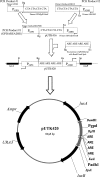Saccharomyces cerevisiae BLYAS, a new bioluminescent bioreporter for detection of androgenic compounds
- PMID: 17675419
- PMCID: PMC2074987
- DOI: 10.1128/AEM.00589-07
Saccharomyces cerevisiae BLYAS, a new bioluminescent bioreporter for detection of androgenic compounds
Abstract
A Saccharomyces cerevisiae strain, capable of autonomous bioluminescence, was engineered to respond to androgenic chemicals. The strain, S. cerevisiae BLYAS, contains the human androgen receptor in the chromosome and was constructed by inserting a series of androgen response elements between divergent yeast promoters GPD and ADH1 on pUTK401 that constitutively expressed luxA and luxB to create pUTK420. Cotransformation of this plasmid with a second plasmid (pUTK404), containing the genes required for aldehyde synthesis (luxCDE) and FMN reduction (frp), yielded a bioluminescent bioreporter responsive to androgenic chemicals. Using dihydrotestosterone (DHT) as a standard, the response time and the 50% effective concentration values were 3 to 4 h and (9.7 +/- 4.6) x 10(-9) M, respectively. The lower limit of detection in response to DHT was 2.5 x 10(-9) M, and in response to testosterone it was 2.5 x 10(-10) M. This strain is suitable for high-throughput screening of chemicals with potential for remote environmental monitoring systems because of the assay speed, sensitivity, and self-containment.
Figures



Similar articles
-
Use of Saccharomyces cerevisiae BLYES expressing bacterial bioluminescence for rapid, sensitive detection of estrogenic compounds.Appl Environ Microbiol. 2005 Aug;71(8):4455-60. doi: 10.1128/AEM.71.8.4455-4460.2005. Appl Environ Microbiol. 2005. PMID: 16085836 Free PMC article.
-
Screening of potentially hormonally active chemicals using bioluminescent yeast bioreporters.Toxicol Sci. 2009 Jan;107(1):122-34. doi: 10.1093/toxsci/kfn229. Epub 2008 Nov 7. Toxicol Sci. 2009. PMID: 18996888
-
A new recombinant cell-based bioluminescent assay for sensitive androgen-like compound detection.Biosens Bioelectron. 2005 May 15;20(11):2261-7. doi: 10.1016/j.bios.2004.10.018. Biosens Bioelectron. 2005. PMID: 15797324
-
High-Throughput Analysis of Endocrine-Disrupting Compounds Using BLYES and BLYAS Bioluminescent Yeast Bioassays.Methods Mol Biol. 2020;2081:29-41. doi: 10.1007/978-1-4939-9940-8_3. Methods Mol Biol. 2020. PMID: 31721116
-
A sensitive recombinant cell-based bioluminescent assay for detection of androgen-like compounds.Nat Protoc. 2008;3(12):1895-902. doi: 10.1038/nprot.2008.189. Nat Protoc. 2008. PMID: 19180073
Cited by
-
In vitro reporter assays for screening of chemicals that disrupt androgen signaling.J Toxicol. 2014;2014:701752. doi: 10.1155/2014/701752. Epub 2014 Nov 9. J Toxicol. 2014. PMID: 25435875 Free PMC article. Review.
-
Reporter proteins in whole-cell optical bioreporter detection systems, biosensor integrations, and biosensing applications.Sensors (Basel). 2009;9(11):9147-74. doi: 10.3390/s91109147. Epub 2009 Nov 17. Sensors (Basel). 2009. PMID: 22291559 Free PMC article.
-
Design of Four Small-Molecule-Inducible Systems in the Yeast Chromosome, Applied to Optimize Terpene Biosynthesis.ACS Synth Biol. 2023 Apr 21;12(4):1119-1132. doi: 10.1021/acssynbio.2c00607. Epub 2023 Mar 21. ACS Synth Biol. 2023. PMID: 36943773 Free PMC article.
-
Standardized application of yeast bioluminescent reporters as endocrine disruptor screen for comparative analysis of wastewater effluents from membrane bioreactor and traditional activated sludge.Ecotoxicology. 2015 Dec;24(10):2088-99. doi: 10.1007/s10646-015-1556-z. Epub 2015 Oct 15. Ecotoxicology. 2015. PMID: 26471181
-
The evolution of the bacterial luciferase gene cassette (lux) as a real-time bioreporter.Sensors (Basel). 2012;12(1):732-52. doi: 10.3390/s120100732. Epub 2012 Jan 11. Sensors (Basel). 2012. PMID: 22368493 Free PMC article. Review.
References
-
- Andersen, L., R. Goto-Kazeto, J. M. Trant, J. P. Nash, B. Korsgaard, and P. Bjerregaard. 2006. Short-term exposure to low concentrations of the synthetic androgen methyltestosterone affects vitellogenin and steroid levels in adult male zebrafish (Danio rerio). Aquat. Toxicol. 76:343-352. - PubMed
-
- Blankvoort, B. M. G., E. M. de Groene, A. P. van Meeteren-Kreikamp, R. F. Witkamp, R. J. Rodenburg, and J. M. Aarts. 2001. Development of an androgen reporter gene assay (AR-LUX) utilizing a human cell line with an endogenously regulated androgen receptor. Anal. Biochem. 298:93-102. - PubMed
-
- Daunert, S., G. Barrett, J. S. Feliciano, R. S. Shetty, S. Shrestha, and W. Smith-Spencer. 2000. Genetically engineered whole-cell sensing systems: coupling biological recognition with reporter genes. Chem. Rev. 100:2705-2738. - PubMed
-
- Fang, H., W. Tong, W. S. Branham, C. L. Moland, S. L. Dial, H. Hong, Q. Xie, R. Perkins, W. Owens, and D. M. Sheehan. 2003. Study of 202 natural, synthetic, and environmental chemicals for binding to the androgen receptor. Chem. Res. Toxicol. 16:1338-1358. - PubMed
-
- Gaido, K. W., L. S. Leonard, S. Lovell, J. C. Gould, D. Babaï, C. J. Portier, and D. P. McDonald. 1997. Evaluation of chemicals with endocrine modulating activity in a yeast-based steroid hormone receptor gene transcription assay. Toxicol. Appl. Pharmacol. 143:205-212. - PubMed
Publication types
MeSH terms
Substances
LinkOut - more resources
Full Text Sources
Other Literature Sources
Molecular Biology Databases
Miscellaneous

